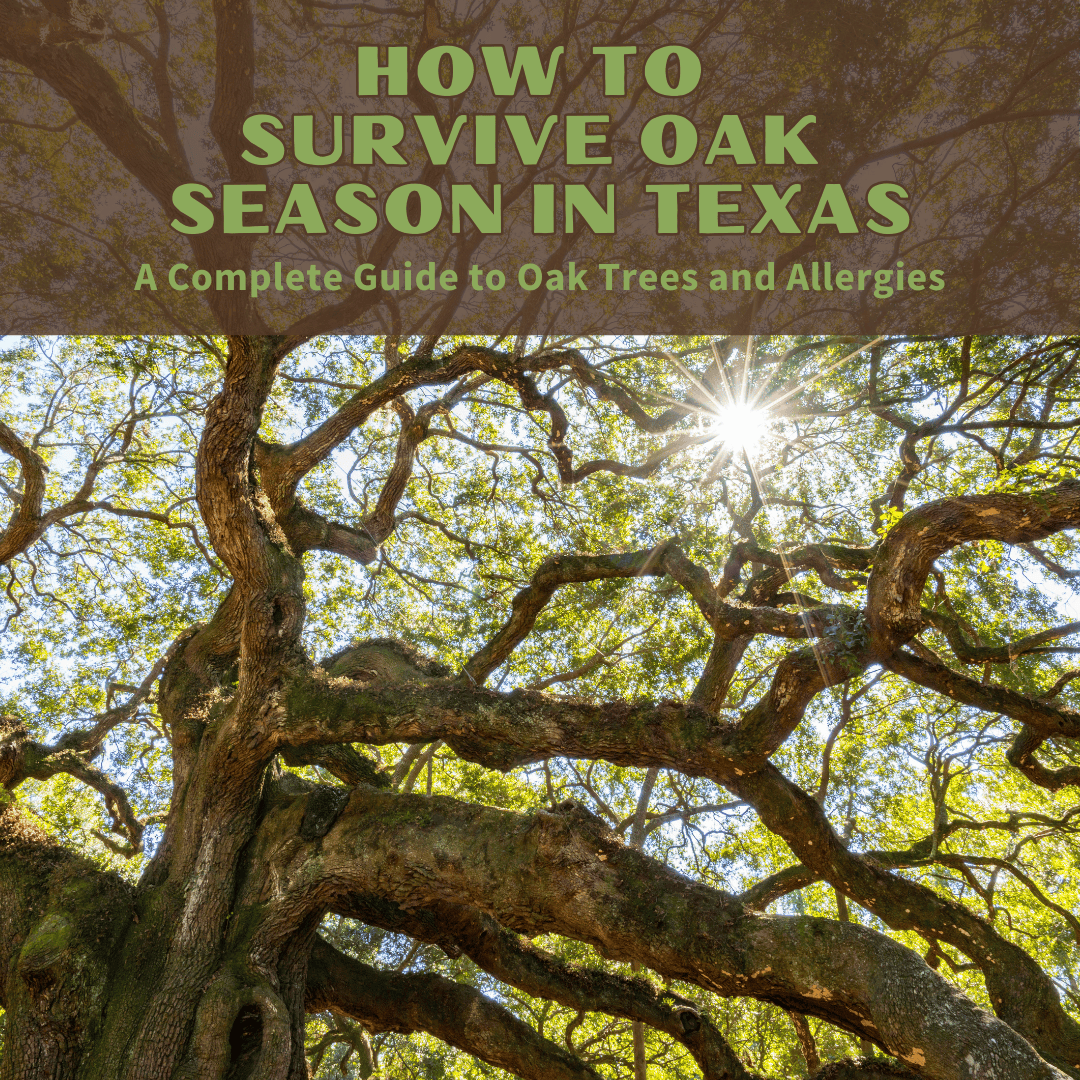Does oak season have you sneezing? Many Texans find themselves suffering from the spring allergen, while also trying to keep their yards and cars clear of oak pollen. If you find yourself reaching for the tissues, read on for a detailed look at all things oak in Texas.
Table of contents
When is oak season?
Oak season starts in the spring and generally ranges from early March to mid-May, with a peak in April. Due to climate changes allergy seasons are lasting longer.
How bad are oak allergies?
Oak trees are one of the most common species of trees in the Northern Hemisphere. Some people are more sensitive to oak allergies due to cross-reactivity between other pollens, including birch, alder and timothy grass.
Symptoms of oak allergies
- Sneezing
- Stuffy or runny nose
- Watery or itchy eyes
- Coughing or throat irritation
- Congestion
- Fatigue or dark circles under the eyes
- Headaches
- Difficulty breathing or asthma
What makes oak allergies worse?
Rains during the fall before the trees go dormant, as well as during the spring can cause an abundance of pollen and increase allergies.
What does oak pollen look like?
The pollen from oak trees are flowers known as catkins or worm-shaped tassels that are typically wind-pollinated. They can range in color from yellow to red or brown. They are a source of food for birds and other wildlife.

What type of oak trees cause allergies in Texas?
Texas has over 50 different species of oak trees. The most common types of allergenic oak trees are Live Oak, Burr Oak and Post Oak.
Common Texas Oaks

Live Oak trees are also known as southern live oak, due to being a common sight throughout the Southeastern coastal plains of the United States. These trees can often exceed 50 feet in height, typically have evergreen leaves (although they can lose leaves during cold snaps), and are known for being tolerant to fire, drought and high soil salinity. Due to their deep and extensive taproots and low center of gravity they can be extremely resistant to strong sustained winds, such as during a hurricane. Live oak pollen generally is dispersed between March and April.

Burr Oak, also known as Bur Oak, is native to Central North America, but can grow in many climates, from as far south as the border of Texas and Mexico, all the way up to Anchorage, Alaska. They are slow-growing, but can get as tall as 98 feet, with a trunk width up to 10 feet and live up to 400 years. Similar to Live Oaks, Burr Oaks have very long taproots, are resistant to fire and drought tolerant. Their pollen generally appears after the first of April in Texas.

Post Oak trees are native to the Southeastern and Midwestern parts of the United States. It's relatively small, growing up to 49 feet. They generally grow in dry areas with poor soil and are resistant to rot, fire and drought. Post Oak gets its name for its common usage in construction, due to its resistance to decay. It's commonly used for Central Texas barbecue. Their pollen generally appears in March in the South.
Oak and Oral Allergy Syndrome (OAS)
Have you ever experienced a strange sensation in your mouth after eating raw fruits or vegetables? You may be suffering from Oral Allergy Syndrome or OAS.
What is OAS?
OAS is a type of allergic reaction that occurs when eating certain raw vegetables, fruits and nuts.
Why does OAS occur?
OAS occurs due to the similarity between pollen and the proteins found in some foods. These proteins confuse the immune system into thinking there's an allergen present and cause an allergic reaction.
Who does OAS affect?
OAS affects individuals who suffer from allergic rhinitis due to pollen, also known as hay fever.
What are the symptoms of OAS?
Symptoms of OAS include itchiness, tingling or swelling of the mouth, lips, tongue and throat, after eating certain raw fruits, vegetables and nuts.
Is OAS dangerous?
OAS can cause severe throat swelling, which can lead to difficulty swallowing or breathing, but this is rare. Anaphylaxis can occur, but is uncommon. Let your doctor know if you experience any new or severe symptoms or if you experience a reaction to nuts.
How to Avoid OAS
Cooking and/or removing any skins of the foods that cause the issue can help to control symptoms. Symptoms can also get worse during the allergy season, so avoiding those foods when your allergies are bad can also be helpful.
Which foods trigger OAS for oak allergy sufferers?
The triggering foods may vary, but a list of common foods that may be associated with OAS in oak allergy sufferers include:

Benefits of oak trees and pollen
Before you start chopping down the oak trees in your yard, be sure to consider the benefits that these trees serve.
Food and shelter for wildlife
Oak trees provide support to thousands of different species of wildlife. Acorns are an important food source for a variety of birds, including quail, wild turkeys, ducks, whooping cranes and jays, squirrels, deer and even black bears. Many mammals make their nests in or around oak trees, and use their shade to stay cool during the summer months. They are also an essential shelter for migrating songbirds.
Wood
Oak is commonly used as lumber due to its strength, durability and resistance to decay. Live oak wood was historically used as framework for naval ships, including the USS Constitution. Burr oak and Post oak are often used in construction including for cabinetry, flooring, siding and fence posts.
Mulch
Oak catkins are easily compostable, but also make great mulch. Mowing them into your grass and raking the flowers from hard surfaces and applying to your gardens are both great ways to protect and feed your soil in an eco-friendly way.
How to prevent oak allergies
Now that we've learned all about oak trees and their prevalence throughout the world, here are a few ways to avoid oak allergies.

Check pollen counts
Checking your local pollen counts daily can help you to better plan your day. On days with high levels of oak pollen, you'll know that you need to be better prepared to avoid or deal with oak allergy symptoms.
Stay inside
Pollen is more abundant in the mornings between 5am to 10am, and on warm, dry and windy days. Avoiding being outside during those times can help to keep your symptoms at bay. Keeping the windows and doors closed and using a HEPA air filter are key on those high pollen days.
Watch for pollen on clothes, hair and pet fur
Pollen is very sticky and will grab on to anything it can. If you or your furry friend have spent time outside, be sure to change your clothes, take a shower and wipe down your pet when you come back in.
Wear a face mask
If you have to be outside when you know oak pollen is abundant, wear a face mask that covers your mouth and nose to prevent breathing in pollen.
How to manage oak allergy symptoms naturally
When you're not able to prevent the allergy symptoms there are a few things you can do to help improve them naturally.

Nasal rinse or saline spray
Clearing pollen from your nasal passages can help to reduce congestion, as well as moisturize dry sinuses. This is an easy and low-cost way to improve nasal symptoms and can help to reduce the need for other treatments. It's important to follow all instructions when using a nasal rinse to prevent serious issues.
Probiotic foods
Adding live cultures of probiotics to your diet through yogurt, sauerkraut or kimchi may help to prevent and treat seasonal allergy symptoms and balance the immune system.
Spirulina
Spirulina is a dietary supplement made up of dried cyanobacteria or blue-green algae. It contains numerous essential nutrients including protein, B vitamins, iron, and fatty acids. Historically, the Aztecs used spirulina as a food source. Recent studies have shown 2000mg of spirulina daily can reduce inflammatory responses to allergens and increase immune function in those suffering from allergic rhinitis. There are contraindications for certain conditions and medications. Always check with your healthcare provider before starting any supplement.
Seasonal Allergy Formula
Our Seasonal Allergy Formula is a homeopathic blend specifically formulated for a variety of allergens including Oak, Ragweed, Dust and Elm in Texas and throughout the United States. Seasonal Allergy Formula is tasteless, dairy, gluten and alcohol-free and safe to use with pets. We recommend taking 6-10 drops every 4 hours while experiencing allergies.




